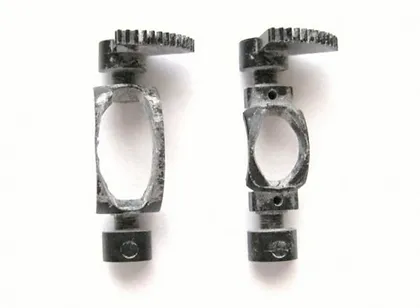Issues with the N64 analog stick – 2.2

The Issues
Let’s discuss the issues with the N64 analog stick. While the problems are easy to identify, it’s crucial to understand their specific locations, namely the gears and bowl. This knowledge will help us determine the tools and resources necessary to fix and repair these components.
Bowl

*The image shows what happens if an N64 bowl is not properly lubed up and played with for quite some time. This dust is a combination of bowl, gear and stick wear.
Over time, the main cause Issues with the N64 analog stick is the friction between the plastic joystick and the plastic bowl. This wear becomes evident as the joystick starts to fall more noticeably into the unit. The rubbing and grinding action of the stick against the bowl result in plastic dust and deterioration, often leading to the accumulation of dust in older and more unstable sticks.
The slots where the gears are situated may also experience some wear, although this is generally as significant as the bowl wear. For instance, if you were to play Mario Party regularly, you wouldn’t likely notice any issues with the slots themselves. Instead, it would primarily be the bowl and gears that would show the most wear and tear. However, the gears will still wear over time without sufficient lubrication.
*White dust is a characteristic of bowl wear (Image source https://www.reddit.com/r/n64/comments/8o4vbm/the_inside_of_a_17_year_old_n64_joystick/)
X/Y axis gears
As demonstrated below, these parts indeed take quite a beating over time. The plastic-on-plastic friction causes significant wear on these parts.


*The top image shows new and unworn gears, The bottom image shows worn gears. These worn gears are a very extreme example of what happens to the gears if not taken care of properly.
The Stick
I would state that this particular part experiences the least amount of wear. However, a small nub on the bottom of the stick causes the bowl to wear out and vice versa. It also contributes to the stick falling into the housing. As this nub flattens, it diminishes the response of the stick. Moreover, over time, the slots where the stick rests against the gate can develop wear. The repeated pressing against the gate widens the slots, as depicted in the picture below.

*Pictured is a very worn N64 stick. Slots and nub at the base of the stick are heaily worn affecting performance. This stick will be harvested for caps (RIP)
Gate
Recently, there has been a growing focus on the N64 gate as a factor that affects performance. The wear on the nubs where the stick connects is evident, as shown below, and it can result in potential wobbling and decreased performance. Furthermore, visible wear is observed to the right of the picture, caused by the stick falling into the module and rubbing against the gate, which leads to additional damage.

*Pictured is a N64 gate with tale tale signs of wear to the stick nubs, shell shaft and upper gate exterior.
Links and extra reading
- The link below showcases the impact of wear on the analog movement, highlighting different levels of wear, particularly on the red controller. By analyzing these readings, you can determine the most utilized controller movements and parts, and it’s truly fascinating. The red controller demonstrates significant wear in all directions, except for the downward movement, which shows relatively less wear. In most games, players extensively push the stick forward, sometimes with great force, and these readings clearly reflect that. It presents an excellent visual representation of the issues associated with the N64 analog stick. https://www.tapatalk.com/groups/nintendo_64_forever/n64-thumbstick-test-program-t6684.html#p68534